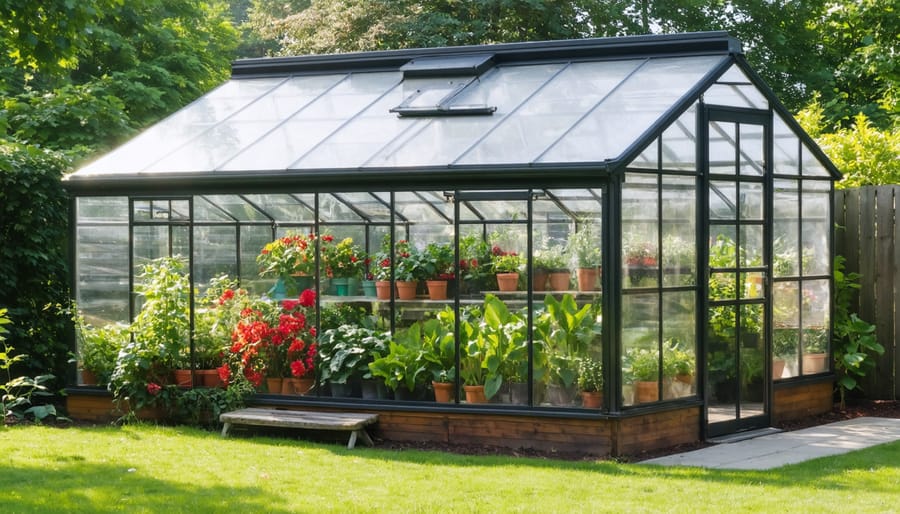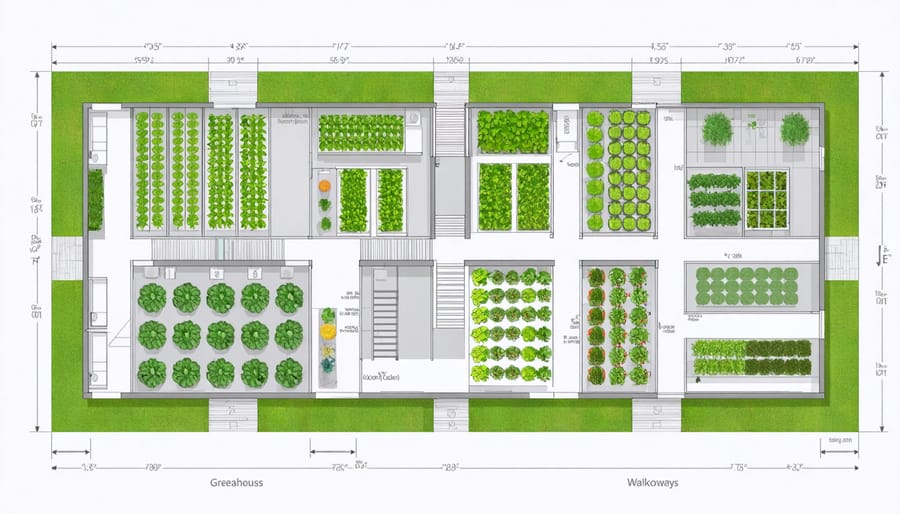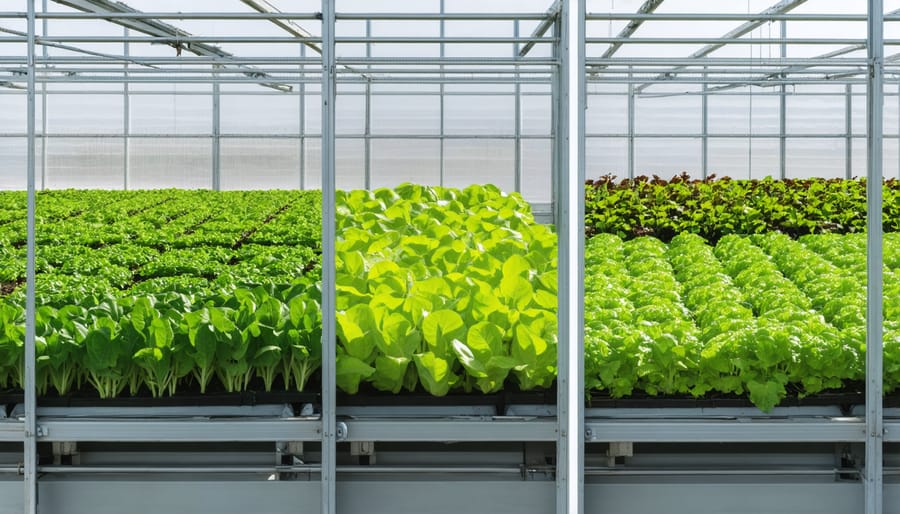Build Your Perfect 3 Season Greenhouse: Extend Your Growing Season Without Breaking the Bank

Transform your backyard into a thriving garden oasis with a three-season greenhouse, the perfect balance between cost-effective sustainable greenhouse gardening and practical year-round growing. Unlike fully heated winter greenhouses, these smart structures harness natural solar energy and thermal mass to extend your growing season by up to four months, letting you start seeds earlier in spring, protect tender plants through fall frosts, and harvest fresh vegetables well into December. By focusing on passive solar design principles and strategic ventilation, three-season greenhouses offer an achievable way to dramatically boost your garden’s productivity without the complexity and operating costs of year-round structures. Whether you’re a weekend gardener or aspiring market farmer, this adaptable growing space provides the perfect stepping stone into protected cultivation while maintaining harmony with natural seasonal cycles.
What Makes a 3 Season Greenhouse Different

Temperature Management Features
Effective temperature management is crucial for a 3-season greenhouse, and implementing the right combination of energy-saving upgrades can help maintain ideal growing conditions. Start with proper ventilation by installing adjustable vents near the roof and sides to create natural airflow. Roll-up sides are particularly effective for hot summer days, while automatic vent openers respond to temperature changes without constant monitoring.
Shade cloth or UV-resistant panels can reduce intense sunlight during peak summer months, preventing plant stress and overheating. Consider installing a combination of fixed and removable shade solutions to adapt to changing seasons. For cooling, strategically placed fans help circulate air, while misting systems can provide additional temperature control on particularly warm days.
During spring and fall, these features work together to maintain comfortable growing conditions without the need for expensive climate control systems, making your greenhouse both practical and efficient.
Seasonal Flexibility
A 3-season greenhouse adapts beautifully to changing weather conditions, making it perfect for enthusiastic gardeners who want to extend their growing season. In spring, the structure captures warmth and protects tender seedlings from late frosts, giving you a head start on the growing season. During summer, proper ventilation through roll-up sides and roof vents prevents overheating while still protecting plants from harsh elements and pests.
As fall approaches, the greenhouse maintains warmth longer than outdoor gardens, allowing you to harvest well past the first frost. You can easily modify growing conditions by adjusting ventilation, adding shade cloth in summer, or using row covers for extra warmth in cooler months. This flexibility means you can grow cool-season crops in spring and fall while nurturing heat-loving plants during summer.
Unlike year-round greenhouses, 3-season structures require less heating and maintenance, making them more practical and cost-effective for most home gardeners.
Smart Design Elements for Maximum Growing Success
Materials and Construction
When building a 3 season greenhouse, selecting the right eco-friendly building materials is crucial for success. Polycarbonate panels are an excellent choice for walls and roofing, offering better insulation than glass while being more durable and lighter. For the frame, consider aluminum or treated wood – aluminum won’t rust and requires minimal maintenance, while wood provides natural insulation and aesthetic appeal.
Foundation options include concrete footings or pressure-treated wooden bases raised slightly off the ground. Ensure proper drainage by incorporating a slight slope and gravel base. The structure should include adequate ventilation through roof vents and side windows that can be opened as needed.
For optimal performance, install a proper door seal and automatic vent openers that respond to temperature changes. Consider adding shade cloth attachments for summer heat management. The size should allow for comfortable movement while working with plants, typically with a minimum 6-foot ceiling height and 3-foot-wide pathways between growing areas.
Layout and Space Planning
Efficient space planning in your three-season greenhouse maximizes growing potential while maintaining good air circulation. Start by positioning taller plants and climbing varieties along the north wall to prevent shading shorter plants. Create tiered growing areas using shelving or staging, with heat-loving plants like tomatoes and peppers on upper levels where temperatures are higher.
Divide your greenhouse into distinct zones based on plant needs. Designate areas for seedling propagation, mature plants, and hardening off. Include a central walkway at least 2.5 feet wide for easy access to all areas. Install adjustable shelving that can be reconfigured as your growing needs change throughout the seasons.
For maximum efficiency, place cold-sensitive plants in the center of the greenhouse where they’re better protected from temperature fluctuations. Create micro-climates by grouping plants with similar water and temperature requirements together. Remember to leave space near ventilation points for good air movement and include a small work area for potting and maintenance tasks.
Consider vertical growing options like hanging baskets and wall-mounted planters to utilize overhead space effectively while keeping floor areas clear for larger containers and ground crops.


Seasonal Growing Calendar
Spring Start-Up
As winter fades, it’s time to prepare your greenhouse for the spring growing season. Start by thoroughly cleaning all surfaces with a gentle soap solution and inspect for any damage from winter weather. Remove debris from gutters and check that all vents are working properly. Test your irrigation system and repair any leaks. Next, sanitize your growing containers and tools to prevent disease spread. Consider adding fresh soil amendments and checking soil pH levels. Install shade cloth if needed, and ensure your thermometer and humidity gauge are working correctly. Set up your plant supports and trellises before bringing in your seedlings. Remember to gradually adjust ventilation as temperatures rise to help your plants acclimate to the changing conditions.
Summer Management
Managing your greenhouse during summer requires strategic planning to prevent overheating and maintain ideal growing conditions. Start by installing proper ventilation, including automatic vent openers and exhaust fans to regulate temperature. Add shade cloth or whitewash the greenhouse panels to reduce intense sunlight and heat buildup. Water plants early in the morning and consider using a misting system to increase humidity. Monitor temperatures closely, aiming to keep them below 85°F (29°C). Position heat-sensitive plants away from direct sunlight and group plants with similar water needs together. Remember to open doors and vents early in the day before temperatures rise too high, and consider using oscillating fans to improve air circulation and prevent disease.
Fall Extension
As autumn approaches, your three-season greenhouse becomes invaluable for protecting plants from early frosts and cooling temperatures. By adding row covers inside the greenhouse, you can create an extra layer of warmth for tender plants. Installing thermal mass elements, such as water-filled containers or stone pathways, helps retain daytime heat and release it slowly overnight. Maximize light exposure by cleaning greenhouse panels and positioning plant shelves to catch the lower autumn sun angles. Consider adding a small electric fan for air circulation on still days, which helps prevent fungal issues common in fall. With these adaptations, you can often extend your growing season by 4-6 weeks, allowing you to harvest fresh vegetables and herbs well into November in most climate zones. For best results, monitor temperatures closely and gradually transition sensitive plants indoors before the first hard freeze.
Maintenance and Care Tips
Regular maintenance is key to keeping your 3 season greenhouse functioning efficiently. Start each growing season by thoroughly cleaning all surfaces with mild soap and water, paying special attention to the glazing to maximize light transmission. Check seals around doors and vents, replacing any damaged weatherstripping to maintain proper temperature control.
Monthly inspections should focus on checking for loose hardware, adjusting vent mechanisms, and clearing debris from gutters if installed. Clean fallen leaves and plant matter from the base of your greenhouse to prevent pest problems and disease. During the growing season, maintain proper ventilation by regularly checking and adjusting vents and fans.
As winter approaches, perform essential winterizing tasks. Remove all plant material and thoroughly sanitize surfaces with a garden-safe disinfectant. Check for and repair any damaged panels or structural elements. If your region experiences heavy snow, install support braces to prevent collapse under snow weight.
For seasonal transitions, gradually adjust ventilation and shading to match changing weather patterns. Test irrigation systems regularly and clean filters monthly during the growing season. Consider installing an automatic vent opener to maintain consistent temperatures when you’re away.
Remember to lubricate moving parts like door hinges and vent mechanisms twice yearly. By following these maintenance routines, you’ll extend the life of your greenhouse and ensure optimal growing conditions throughout your three growing seasons.
A 3 season greenhouse offers the perfect balance between functionality and practicality for home gardeners. By extending your growing season through spring, summer, and fall, you can enjoy fresh produce and beautiful plants for most of the year without the high costs of winter heating. The protected environment shields your plants from harsh weather, pests, and temperature fluctuations, while giving you the flexibility to grow a wider variety of crops than outdoor gardening alone. Whether you’re a seasoned gardener or just starting, investing in a 3 season greenhouse can transform your gardening experience and boost your harvest yield. Take the first step today by planning your greenhouse project – you’ll be amazed at how this versatile structure can enhance your gardening journey and provide you with months of growing enjoyment.

